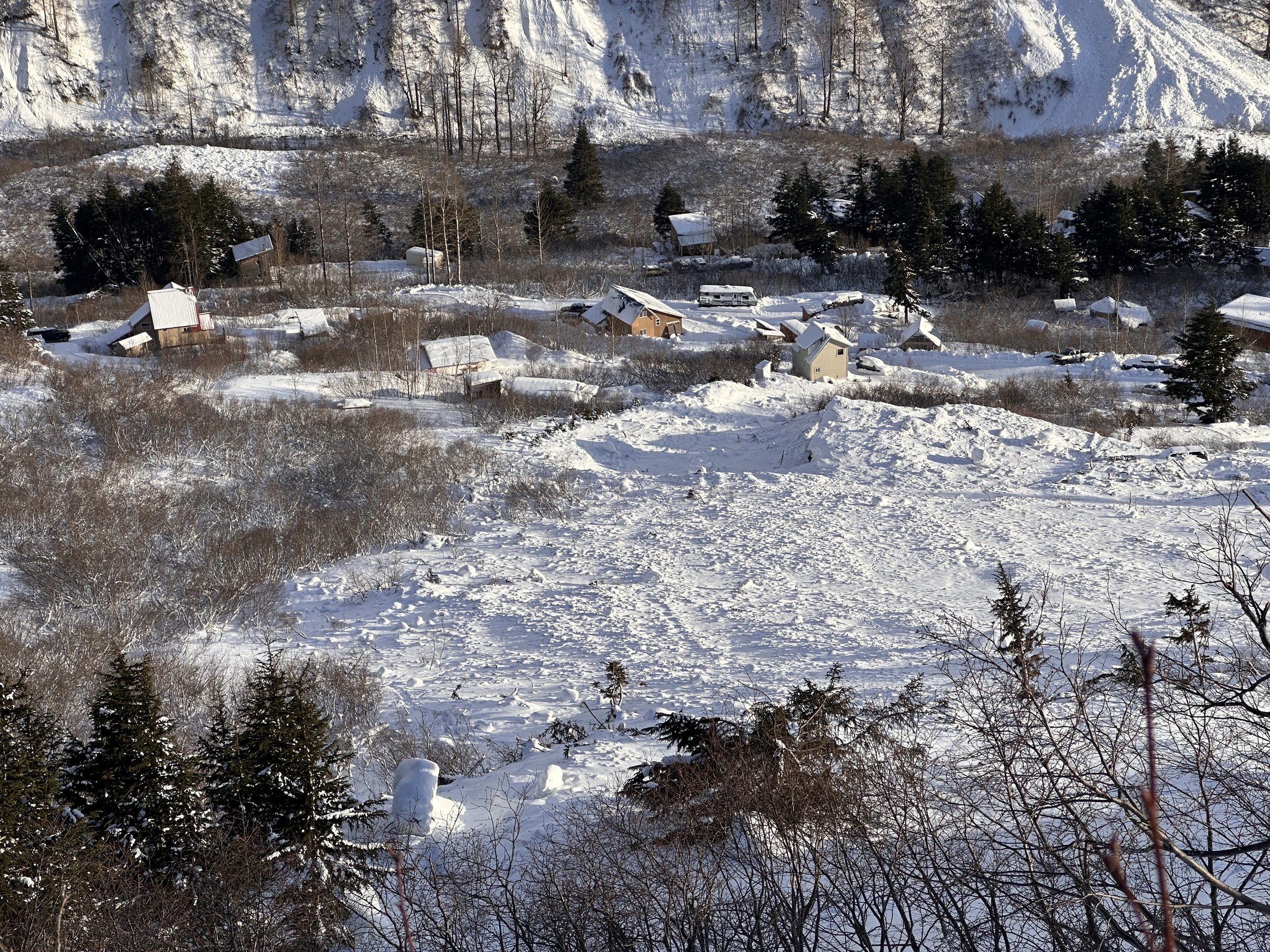Late January Avalanches were close calls
An aerial view a day after the Jan.28 avalanche above upper Crow Creek. (Photo courtesy of USFS)
By Soren Wuerth
TNews Editor
We all live at the mercy of Mother Nature, as on-going ecological catastrophes attest.
For people living below the shadow of a mountain, in the path of an avalanche, the reverberations of this reckoning become particularly poignant.
Centuries ago, the Incas brought young women to the peaks of mountains in sacrifice. They revered the mountain deity "Apus", protector of land and animals. In the Peruvian highlands, folklore still has locals crafting gifts for mountain spirits.
In Nepal prayer flags flutter along ancient trails and pilgrims chant the words, om mani padme hum.
For Norwegians, the Bergrisi, or "mountain giant", guards craggy peaks and could command or prevent an avalanche.
In Chinese mythology, mountains were said to hold up the sky.
Two Girdwood avalanches, one in upper Crow Creek and another on Mt. Alyeska came so close to disaster, it was as if an Apus or Bergrisi had been summoned.
Though the slides were considerable in both locations, no one was hurt and property escaped damage.
An avalanche that shed from Ragged Bowl above a small community along upper Crow Creek Road during a late January evening passed beside one cabin, went over the top of a vacant garage and stopped short of several homes.
An avalanche stopped just short of homes in the Crow Creek neighborhood near Girdwood. (Photo by Soren Wuerth)
Avalanche forecasters had warned of "high" danger during a turbulent storm that brought wind, rain and a half dozen feet of snow in places.
During the storm, one resident thought he'd heard something, an earthquake he thought, but outside he couldn't see much beyond a white-flurried gale.
When another local woke up the next day, he saw the avalanche beside, beneath and above his home. The avalanche sailed over the top of a vacant steel and concrete garage (designed for such events) loading the roof with feet of snow, branches and debris and came to a stop just before a house.
In the end, only an abandoned car and fish smoker were damaged.
Meanwhile, across the valley, an avalanche thundered below Chair 6 which had, only minutes before, called "last chair", according to employees posting on social media.
It is the third avalanche at Alyeska in a row of ski seasons. The "Slush Cup" slide swept down a face known as "Headwall" last spring, a day after the Resort closed. A year earlier, an avalanche barreled down the mountain's north face, displacing kettle ponds, flooding the lower levels of the hotel and sweeping near the Resort's new outdoor spa.
Predicting avalanches using snow science and modern forecasting is only so good. An avalanche expert once told me a skilled backcountry skier can only be accurate up to 90 percent of time. "That means if you travel 100 times in the backcountry, on 10 occasions you put yourself at risk," he said.
For people living in what is called an "urban interface" knowing the stability of a looming snowpack is critical, but conditions are hard to assess and "every winter is unique and has its own circumstances," said Wendy Wagner, director of the Chugach National Forest Avalanche Information Center.
"If I learned anything, snow doesn't play by the rules and it can do anything when we don't expect it to," Wagner said. "Lots of people want answers and there aren't any."
Locals tell about another Raggedtop avalanche in the late 90s that came down to the road. One car had a window slightly cracked open and snow packed in so densely, "you couldn't hardly pick it with an ice pick."
The extent of avalanche paths in places around Anchorage were calculated in a 1982 study that established zones of risk.
That study, "Snow Avalanche Zoning Analysis", identified avalanche runout zones using various colors.
"The subdivision [of zones] is arbitrary because it depends on the level of risk individuals or governments are willing to accept," the report states.
The study conceded difficulties in its preparation such as a lack of historical data on avalanches in the Anchorage municipality, limited climate data and a lack of aerial maps.
"... We must all recognize that this avalanche zoning analysis, although utilizing the best available data and methods, is seriously limited by the short period of record," the report concluded. "If our above recommendations are followed, new information will eventually affirm, modify, or negate some of our conclusions."
Most slides occur during or after a warm, windy, and rainy storm, weather patterns that have become a feature of Southcentral winters. Scientists attribute more severe and unpredictable weather to a warming climate, the result of a planet heating from, principally, oil pollution.
At the end of Crow Creek Road on a recent Sunday a blue Subaru sits unoccupied, its passengers having scuttled up a trail toward a snowy valley.
Hanging inside its windshield, a string of colorful Tibetan prayer flags, soft homages to our fickle mountains.


